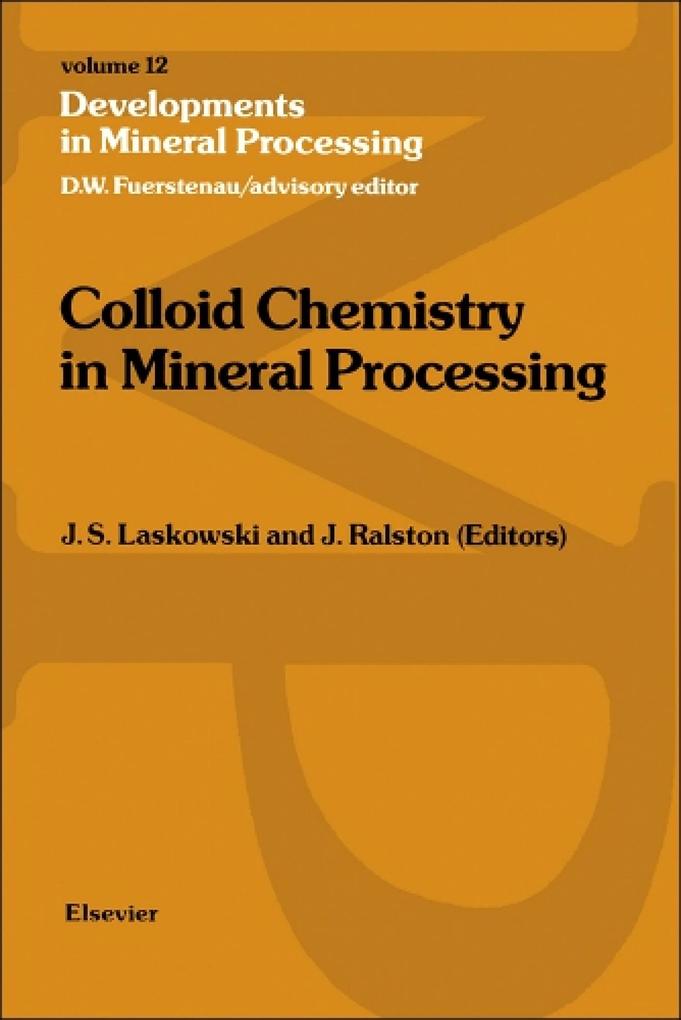Within this volume is a thorough coverage of the fundamental principles embracing modern theories of colloid chemistry applied to mineral processing. It is written in respect for Dr. J. A. Kitchener, distinguished Reader in the Science of Mineral Processing in the Royal School of Mines, Imperial College, University of London (recently retired). Dr. Kitchener's expertise in colloid chemistry has led to numerous fundamental insights and practical advances in flotation, selective flocculation, and the treatment of slimes. Colloid chemistry is inevitably involved in all aspects of mineral processing, ranging from how collectors selectively adsorb on to mineral surfaces in flotation, to the forces which control the stability of dispersions of submicron particles, as well as embracing the behaviour of hydrolyzed metal ions in solid-water slurries. The intelligent use of this information is essential in the effective design of separation processes and strategies by the mineral processor. Up to date bibliographies are included at the end of each of the 13 chapters making this volume a useful general resource for researchers, students and mineral processors.
Inhaltsverzeichnis
1;Front Cover;1 2;Colloid Chemistry in Mineral Processing;4 3;Copyright Page;5 4;Table of Contents;12 5;Foreword;6 6;List of Contributors;10 7;Part 1: Fundamentals;20 7.1;Chapter 1. Minerals and surfaces;22 7.1.1;Foreword;22 7.1.2;Colloids and surfaces;23 7.1.3;Mineral surfaces;46 7.1.4;References;56 7.2;Chapter 2. Adsorption;58 7.2.1;Introduction;58 7.2.2;Thermodynamics of adsorption from solution;58 7.2.3;Adsorption from solution in a monolayer;67 7.2.4;Ion adsorption;74 7.2.5;Adsorption of organic molecules;88 7.2.6;References;111 7.3;Chapter 3. Interparticulate forces;118 7.3.1;Introduction;118 7.3.2;DLVO theoiy;119 7.3.3;Structural forces;125 7.3.4;Conclusions;134 7.3.5;References;134 7.4;Chapter 4. Dispersions stability and dispersing agents;136 7.4.1;Introduction;136 7.4.2;Dispersing/depressing agents in mineral processing;137 7.4.3;Classification of dispersing agents;138 7.4.4;Particle interactions in dispersed systems;144 7.4.5;Dispersing agents at solid/liquid interfaces;159 7.4.6;Stability measurements of dispersed systems;169 7.4.7;Industrial applications;179 7.4.8;References;187 7.5;Chapter 5. Static and dynamic contact angles;194 7.5.1;Introduction;194 7.5.2;Static contact angles;194 7.5.3;Dynamic contact angles;218 7.5.4;Summary;220 7.5.5;References;221 7.6;Chapter 6. The influence of particle size and contact angle in flotation;224 7.6.1;Introduction;224 7.6.2;Kinetic considerations in bubble-particle interaction;225 7.6.3;Bubble-particle aggregate stability;233 7.6.4;References;244 8;Part 2: Applications;246 8.1;Chapter 7. An introduction: physicochemical methods of separation;248 8.1.1;Introduction;248 8.1.2;General classification of separation methods;249 8.1.3;References;263 8.2;Chapter 8. Selective coagulation of colloidal mineral particles;266 8.2.1;Introduction;266 8.2.2;DLVO theory applied to selective coagulation;267 8.2.3;Selective coagulation in binary mineral mixtures;275 8.2.4;Latex/mineral mixtures;280 8.2.5;Clay mixtures;282 8.2.6;Natu
ral water systems;286 8.2.7;Different sized particles;290 8.2.8;Selective coagulation of mineral slimes in magnetic separation processes;290 8.2.9;Selective coagulation by hydrophobic forces;295 8.2.10;Selective coagulation by magnetic and hydrophobic forces;296 8.2.11;Suspension filtration processes;296 8.2.12;Other examples of selective coagulation of mineral particles reported in the literature;296 8.2.13;Acknowledgement;298 8.2.14;References;298 8.3;Chapter 9. Flocculation;300 8.3.1;General flocculation;300 8.3.2;Selective flocculation;314 8.3.3;Acknowledgements;329 8.3.4;References;329 8.4;Chapter 10. Shear-flocculation;332 8.4.1;The shear-flocculation effect;332 8.4.2;Parameters affecting shear-flocculation;334 8.4.3;Measurement of the degree of shear-flocculation;341 8.4.4;Theory of shear-flocculation;343 8.4.5;Applications;349 8.4.6;Conclusions;351 8.4.7;References;351 8.5;Chapter 11. Coating and carrier methods for enhancing magnetic and flotation separations;354 8.5.1;Introduction;354 8.5.2;Different types of carrier and coating process;354 8.5.3;Forces of interaction controlling the adhesion of fines;370 8.5.4;Kinetic aspects;376 8.5.5;Final remarks;377 8.5.6;Appendix List of symbols;378 8.5.7;References;379 8.6;Chapter 12. Oil assisted fine particle processing;384 8.6.1;Water/liquid hydrocarbons two phase systems;384 8.6.2;Competitive wetting of solid particles with immiscible liquids;396 8.6.3;Emulsion flotation;403 8.6.4;Extender and agglomerate flotations;409 8.6.5;Liquid phase agglomeration;410 8.6.6;Liquid-liquid extraction;413 8.6.7;Acknowledgements;414 8.6.8;References;414 8.7;Chapter 13. Fundamental aspects of microbubble flotation processes;418 8.7.1;Introduction;418 8.7.2;Generation and properties of microbubbles;419 8.7.3;The theoretical effect of bubble size on the mechanism of flotation;424 8.7.4;Experimental studies on flotation by microbubbles;430 8.7.5;Applications of microbubble flotation processes;436 8.7.6;The potential and future of m
icrobubble flotation;437 8.7.7;References;439 9;Subject Index;442










